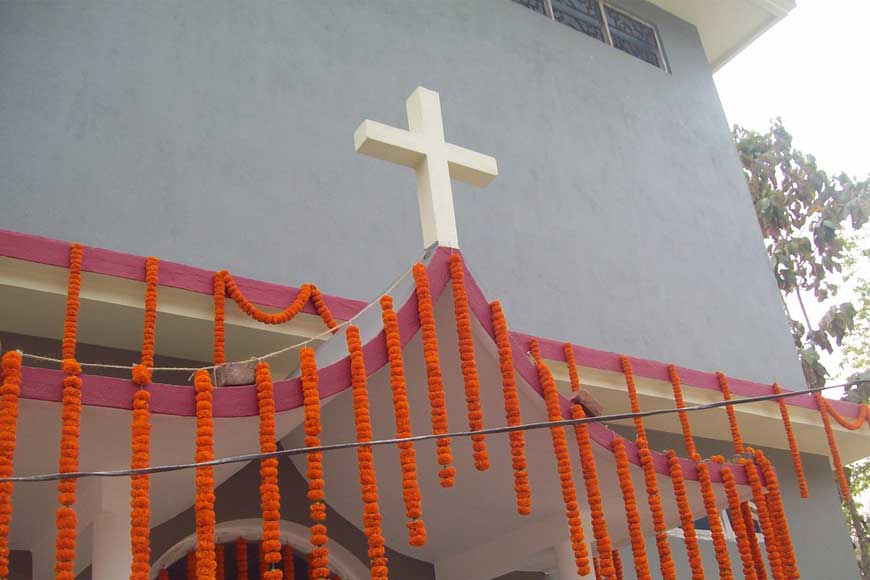Dawn of Christianity in North Bengal and its historical churches

When we talk about churches of Bengal, we are always drawn towards the well-known St Paul’s Cathedral or the St John’s Church of Kolkata, or the Armenian Church, Greek Church and so on. But interestingly, the dawn of Christianity in North Bengal, that was primarily used by the colonial powers for their business and luxury travel interests had a different trajectory along which Christianity found a strong foothold among the tribals of Jalpaiguri, Alipurduar, Siliguri, Kurseong, Kalimpong and ofcourse the Queen of the Hills, Darjeeling.
The first Adventist to enter the territory of North Bengal was Dores Alanzo Robinson in February 1896, who visited Darjeeling just three months after he arrived in India. In 1899, Robinson conducted a series of meetings in the local town hall, but after some objections from local Christians, he had to move it to a large room offered by a hotel owner. Several locals were baptized, but within a few years, many members had moved away. While Sister Jewet and her daughter were canvassing in Darjeeling in 1903, they came across a Muslim man who came from the tea estates to be baptized.
The earliest local pioneers of Christianity in North Bengal were Upendra Nath Haldar and Jiten Sircar. There is a record of them working in Malda District in 1939 to spread the religion. In Rohanpur, 20 miles from Malda, they had even baptized ten persons. Thus the first Adventist Church in North Bengal was organized in Chakowakheti in 1941. Lal G. Mookerjee reported that a group of persons in Chakoakhali had earlier received the message of the Sabbath from a Punjabi Christian Sadhu through D. K. Seth Kujur, who later taught the children of 15 Sabbathkeepers. D. D. Marjee and his family are reported to have obtained a tract concerning idol worship in the 1930s. Impressed, they wrote to the address on the pamphlet, which was the Calcutta Mission at 36 Park Street. In response, Lal G. Mookerjee was said to have sent Haldar and Jiten Sircar to meet them. On the last Sabbath of December of 1940, ten persons were baptized. Eight more were baptized on April 19 during the Annual Meetings which were held at Chakowakheti in 1941.Those meetings were attended by seven workers and 150 other people. The church was organized that day on April 19 with 21 members. A communion service was conducted as well, and U. N. Haldar was ordained into the ministry.
The seed for the Barobisha Church of Jalpaiguri was sown by U. N. Haldar. However, K. S. Ekka did the follow-up work, traveling from Chakowakheti on bicycle and giving Bible studies. On Sabbath, April 29, 1944, L. G. Mookerjee baptized nine candidates including Joymasih Tirkey and Samuel Bara and organized the church with thirteen members. He also conducted the Lord's Supper and performed a marriage service for Seth Kujur and his wife, a graduate nurse. He mentioned that Bishtoo Boro was the first person from Mech tribe to be baptized among the Boro from Dooars.
Probably the first Adventist to reside in Kalimpong was Catherine M. Raymond in the 1940s, who retired there after her husband F. O. Raymond passed away. She used to give Bible studies and hold Sabbath School in her home. She bequeathed her estate in Kalimpong to the Church, and from that Raymond Fund, the school site in Falakata was purchased. Allan Maberly from Australia was the earliest missionary to work in Kalimpong. He was assisted by a Tibetan, Hsuen Ming Shan, and an Indian, B. L. Albert. Maberly started medical work among the Tibetans daily at six different locations. Services were held in his home. The Kalimpong Church was organized in 1950 by two officers of the Division, Robert H. Pierson and Marin E. Kemmerer. Others present were Eric M. Meleen, Frank E. Spiess, and Amirtham from the Union. With hopes of gaining easier access, Tibet was transferred from China to the Southern Asia Division. R. J. King, another missionary from Australia, dedicated the Church in Kalimpong on June 1, 1959.
The Adventist workers also started spreading to adjoining Sikkim. The first Adventist workers in Sikkim were Iqbal Masih and his wife. In 1975 after Sikkim joined the Republic of India, they were sent to Deorali, Gangtok, where they opened the Himalayan Better Health Clinic. Iqbal, a compounder, and his wife, a nurse, were joined a few months later by Dr. Glenn Christo and his wife, Margaret, who moved there from Ranchi soon after his graduation from Christian Medical College, Vellore. Margaret, an office secretary, quickly learned to give injections and deliver babies since it was against Tibetan culture for a male to examine their women. The clinic was inaugurated formally by the Honorable Chief Minister Kazi Lhendup Dorji, who cut the pink ribbon to officially open the Himalayan Better Health Clinic at Deorali on November 5, 1975.
The Chokowakheti Mission Station was established in 1939 as part of the West Bengal Mission under the leadership of L. G. Mookerjee. However, from 1944-1947, the Chakowakheti Mission Station was administered by the East Bengal Mission (now Bangladesh). After the partition of India and Pakistan in 1947, the North Bengal Mission Field (unorganized) had its headquarters moved back to India. Mission stations at that time were in Barobisha, Chokowakheti, Maktaigaon, Palasguri, and Sathali. In 1949, the North Bengal Mission was reorganized as the North Frontier Mission, and the following year headquarters moved to “Winston,” Kalimpong.
To be continued
(Source: Encyclopaedia of Seventh Day Adventists;
Darjeeling Jesuits site)










